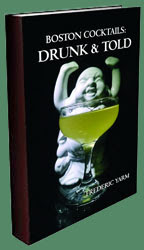1 oz Dry Vermouth (Noilly Prat)
1/2 oz Lime Juice
1/2 oz Orange Juice
1 tsp Sugar
Stir sugar in juices until dissolved. Add rest of ingredients and ice, shake, and strain into a sugar-rimmed cocktail glass. I added an orange twist.
Last Monday was Presidents Day, and Andrea and I wanted to celebrate in style. In Esquire Drinks: An Opinionated & Irreverent Guide to Drinking, David Wondrich provides the recipe for the Presidente Vincent which is a reasonably well known recipe. The drink named after Sténio Vincent, the Haitian president during the 1930s, has some similarities to the classic El Presidente as well as to the Daiquiri. It calls for Haitian rum (although Wondrich recommends substituting Martinician or gold Puerto Rican rum), a full ounce of lime juice, and no orange juice but otherwise the same as the recipe above. The lesser known President Roosevelt variation pays tribute to Franklin's love of Orange Blossoms by splitting the juice portion into half lime and half orange. Trader Vic simplified the drink in the 1948 edition of his book to contain Bacardi, orange juice, and grenadine; while it is closer to a rum-based Orange Blossom, it is a lot less interesting of a flavor profile than the Presidente Vincent variation.


 This month's
This month's 

 1 1/2 oz Gin (preferably Old Raj)
1 1/2 oz Gin (preferably Old Raj)
































 The 2017 collection of 855 drink recipes, bartender tributes, and essays on hospitality from CocktailVirgin's Frederic Yarm. Available at
The 2017 collection of 855 drink recipes, bartender tributes, and essays on hospitality from CocktailVirgin's Frederic Yarm. Available at  The 2012 collection of 505 drink recipes, techniques, and Boston bar recommendations from Frederic Yarm. Available at
The 2012 collection of 505 drink recipes, techniques, and Boston bar recommendations from Frederic Yarm. Available at 



